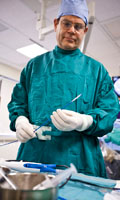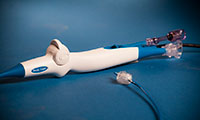Arctic Front
Mending a Fluttering Heart: Catheter to Treat "A-Fib" Shows Positive Results
Since medication helps only about half of the seven million people worldwide who experience atrial fibrillation (AF)—a sustained fluttering or rapid beating of the heart—alternative, catheter-based treatments are vital. Episodes can last for weeks or even longer, leading to fainting, fatigue, difficulty breathing, and chest pain, as well as putting patients at risk for congestive heart failure or stroke.
The Pulmonary Vein Ablation Catheter® (PVAC), the most common nonsurgical treatment for AF, was developed by Emory Professor of Internal Medicine Jonathan Langberg, MD. The multi-electrode catheter is used to map, ablate and verify isolation of the pulmonary veins, streamlining the procedure and reducing the risk of complications.

Jonathan Langberg, MD
The Arctic Front® cryoablation catheter, also based on technology developed by Langberg, was designed to simplify pulmonary vein ablation. Unlike traditional ablation treatments that cauterize single spots, cryoballoon ablation freezes an entire ring of tissue at the junction of the pulmonary veins and left atrium, blocking the conduction of electrical signals that trigger AF. The balloon-based technology of Arctic Front® uses a coolant delivered through the catheter, which expands it against the inside of the heart and freezes the trouble spots. The freezing also helps the balloon maintain contact with the heart tissue.
PVAC was licensed to Biosense Webster, a subsidiary of Johnson & Johnson Company. It has also been sub-licensed to Medtronic and the Arctic Font® is currently being sold by Medtronic Ablation Frontiers LLC.

Arctic Front Device
In June 2010, Medtronic reported positive results from a trial involving AF patients who were treated with the Arctic Front® catheter. Twelve months after treatment, just 20 percent of AF patients reported debilitating symptoms. Patients reported improvements in six categories:
- Palpitations decreased from 86 percent to 25 percent
- Fatigue decreased from 76 percent to 13 percent
- Rapid heartbeat decreased from 66 percent to 16 percent
- Difficulty breathing (dyspnea) decreased from 54 percent to 9 percent
- Dizziness decreased from 48 percent to 9 percent
- Fainting (syncope) decreased from 4 percent to 1 percent.
Since AF is often age-related, as the US population continues to grow older the need for more effective treatments is escalating. "AF really has a negative impact on a person's quality of life," says Laura Fritts, director of patent and licensing strategy at Emory's Office of Technology Transfer. "To see a technology developed here that has the potential to help such a high number of patients is exciting."